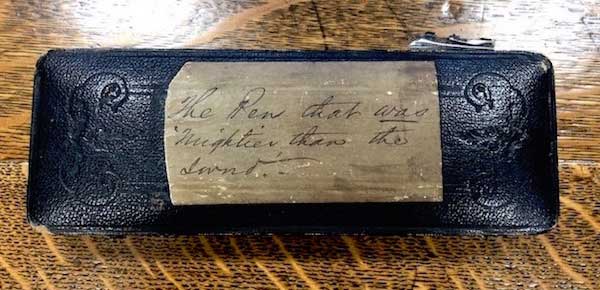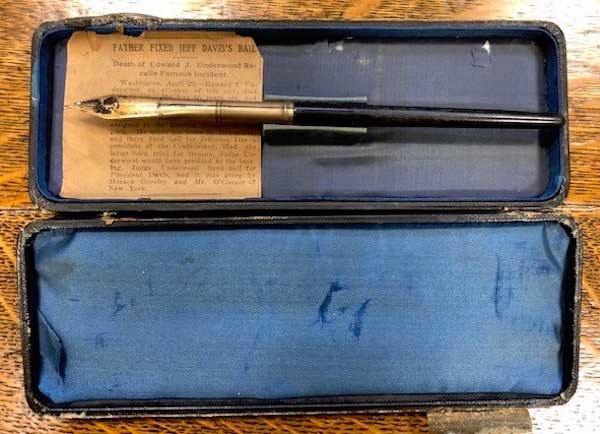Hoag Library has pen used in 1867 to sign bail bond for Jefferson Davis
Photos courtesy of Hoag Library
ALBION – Hoag Library announced today that is has the pen used in 1867 to sign the bail bond for Jefferson Davis, the president of the Confederacy.
The pen was given to Rufus Bullock, the governor of Georgia and an Albion native. Davis was captured in Georgia on May 10, 1865. He was taken to Fort Monroe, Virginia. Although he was accused of treason and plotting in the assassination of Abraham Lincoln, he was never brought to trial.
After two years in prison, he was released and lived out the rest of his life in relative peace in Biloxi, Mississippi, at the Beauvoir plantation. He died in 1889.
The clerk of a U.S. Circuit Court in Virginia gave the pen to Bullock.
Dee Robinson, a reference librarian Hoag Library, will discuss the pen and how it can into the library’s possession during her monthly “Tea with Dee” historical talk. That will be next Tuesday, Oct. 1., at noon.
Robinson said today the quill still has some ink on the tip.
The pen has been in the library’s possession, likely for over a century. It was listed in an inventory of items, but Robinson said she didn’t see it until April. She wanted to research the history behind the pen before going public about it.
The pen was among many items in the library’s archive that were moved from the former Swan Library to the new Hoag Library in 2012.
Robinson has been going through the archives – many boxes and file folders.

Hoag Library also has the box for the pen used to sign Jefferson Davis’s bail bond.
Impeachment parchment
The pen was donated to the library by Bullock, who died in 1907. He gave the library another prized artifact from the post-Civil War.
When Bullock was governor, he was given an impeachment notice signed by the 126 members of House of Representatives who voted Feb. 24, 1868, to impeach Andrew Johnson for “high crimes and misdemeanors.”
Bullock moved back to Albion in his later years and gave the impeachment notice to Swan Library in 1903. The library had only been open for three years at that point. Bullock died at age 73 on April 27, 1907, and is buried near the tower at Mount Albion Cemetery.
For a century that document sat in the attic at Swan Library. Librarians were aware of that piece of history and kept it safe.
But when the community was looking to build a library, Swan leaders thought the impeachment notice might fetch a big dollar and could help get the new building built. Some speculated the document might be worth a million dollars or more.
Library leaders at the time sent a photo of the impeachment parchment and a description to Sotheby’s, the famous international auction house. Its assessment of the document: about $15,000 to $25,000 – a nice sum but library leaders decided it wasn’t a difference maker for the library.
George Washington letter
The pen joins other interesting artifacts in the library’s archives. That includes a letter from George Washington written in May 1784, about five years before he started serving as the first president of the United States. Robinson found the letter in April when she was looking through the archives.
The letter from Washington was written to Jacob Morris, thanking him for taking care of a gift package sent to Marquis de Lafayette, a French aristocrat and military officer who fought in the American Revolutionary War. He led American troops in several battles, including Yorktown.
The letter acknowledges correspondence from Morris in regard to the package of Lafayette, and Washington offers to pay the cost of the delivery, and also extends his compliments to Mrs. Morris. Jacob Morris was the son of Lewis Morris, who signed the Declaration of Independence.
The Journal-Register in Medina on April 19, 1967 wrote about the letter from Washington, which was being put on display briefly at Swan Library. The Journal-Register reported then that a family in Westchester County owned the letter for about 90 years. Thomas Bell then owned it and presented it to Noah Davis, a justice for the State Supreme Court who was from Albion. (Davis was the judge in the trial that brought down New York City Tammany Hall ringmaster William M. “Boss” Tweed. Judge Davis presided over Tweed’s trials on charges of conspiracy, perjury and larceny.)
After his death, Davis’s wife sent the letter to Emma Swan, the founder of the library with her husband William. Mrs. Swan gave the letter to the library. According the JR article, the letter’s authenticity was established by the Historical Society of New York City and by the Astor Library.
The article from 1967 reports the Washington letter is ordinarily kept in bank vault and only seen by a few people.
While The Journal-Register wrote about the Washington letter, Robinson said today she hasn’t found any previous coverage of the pen used to sign Davis’s bail bond.
Susan B. Anthony letter
Robinson was searching through library files in March and found a 1903 letter from Susan B. Anthony, written to the then Swan Library. (The new Hoag Library opened in July 2012.)
Anthony, the women’s rights activist, was a pivotal leader for women’s suffrage. She wrote to the library to encourage Swan to buy four volumes of the History of Woman Suffrage and also two volumes about the life and work of Susan B. Anthony.






































































